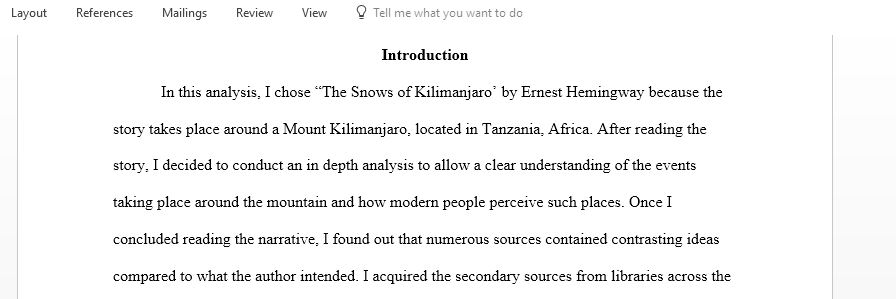Research paper: Ernest Hemingway, “The Snows of Kilimanjaro”
Research paper: Ernest Hemingway, “The Snows of Kilimanjaro” (D: 826). In your paper, begin with a brief introduction in which you tell why you chose this story or play, what questions you had after reading, how your found your sources, which sources were most useful. This introduction is required. You should use “I” in the introduction since you are discussing your personal response.
Include a very brief discussion of the primary source itself, including quotations that you think are important. This part of the paper shouldn’t be more than a paragraph or two. (I emphasize “brief” because in the past, some students have discussed the story, novel, or play for half the paper and responded very briefly to the commentaries.) This part of the paper should be similar to a short reading response.
Then discuss each commentary (source) in a full paragraph for each source, letting the reader know what the critics have said about your story, novel, or play. Include at least two substantial quotations from the source and your responses to what the critics say. You will need to give the name and author of each commentary, but don’t use these as headings. I prefer that you organize your essay by discussing the sources one by one in separate paragraphs. You may, of course, make connections among the sources to make the essay flow nicely. I’m interested in what you find out about the literature through research. Please follow punctuation rules for quotations. Quotation marks don’t substitute for other marks of punctuation (commas, colons, semicolons, periods). Here is a website that should be useful: Punctuating Quotations in Essays
Do not put the author’s name in parentheses after a quotation. You should introduce your source at the beginning of the paragraph by including the author’s name and the title of the source in your topic sentence for the paragraph. You may, of course, mention the author’s name again in a sentence if you wish, but don’t put the author’s name in parentheses. Use sentences like, “Baker goes on to say that. . . .” or “he also says that. . . .”
At the end of the paper, summarize what you have learned by doing the research, perhaps letting your reader know which commentaries answered the questions you had, which gave you additional insight, which were difficult to understand, etc. Again, you should use “I.”
Include a Works Cited list at the end of the paper, listing all sources alphabetically, using MLA documentation format. Be sure to list your primary source (the story, play, or novel you are writing about). You must follow MLA format exactly. If you need help, let me know. You may wish to pick up a handout at the library or consult the following website: MLA Format. The Purdue On-line Writing Lab (OWL) is also very useful.
Answer preview for Research paper: Ernest Hemingway, “The Snows of Kilimanjaro”

Access the full answer containing 1460 words by clicking the below purchase button.

